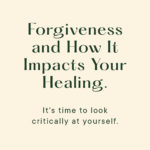Forgiveness is HARD. We hear all the time that we need to forgive and let things go, but it’s not as simple as just saying ‘I forgive you’. Without truly feeling it, and being able to surrender the resentment we are holding onto, those words are total BS.
On The BS We Feed Ourselves, I had the fantastic opportunity to talk to Dr. Keesha Ewers, renowned sexologist and author of ‘Solving the Autoimmune Puzzle’, about treating childhood trauma and advancing our healing journey. She recommended the Heartlight Meditation and today I’d love to share it with you.
Here’s your How to Heartlight Meditation:

Step 1
First, you want to call the person who hurt you in front of you. Imagine them like a hologram that you can dial up. Decide what ego or personality traits drove them to commit the behavior. Identify each trait separately. Some examples might be cruelty, ego, ignorance or bigotry.
Step 2
Identify the traits of the perpetrator in yourself. Now, it may be your first instinct to think that you would never be cruel, or ignorant but keep in mind, the traits may not manifest themselves in the same way they did in the person that wronged you. Sometimes they are more subtle.
For example, Dr. Keesha Ewers mentioned that the person who wronged her was a bigot, but she was very sure she wasn’t a bigot. She had grown up overseas in Japan, spent plenty of time with a variety of people and was very careful not to judge. When she really sat down and thought about it however, she realized she was extremely intolerant of intolerant people.
Now think about the traits of the person who wronged you. How might you be displaying these qualities in your everyday life? Are you passive aggressive? Do you lash out at people who don’t deserve it? We all have both good and bad qualities.
It’s time to look critically at yourself.
Step 3
Once we can put the mirror up and see these traits reflected in ourselves, we can understand what it’s like to be on the other side. We can use this as an opportunity to address our shortcomings, apologize to the people we have wronged and be wary of these traits in the future.
Step 4
Forgive the person who hurt you. For all of you out there thinking the behavior was inexcusable, just remember you don’t have to forgive the behavior. You don’t even have to reconcile with the person. Just recognize that you too display some of these qualities and let the poison of resentment go.
Step 5
Thank them for being your teacher. They gave you the opportunity to learn something about the human condition, and about distorted motivation. What a wonderful way to shift your perspective.

Why This Will Streamline Your Healing
While diet and exercise are vital on your path to getting well, connecting with your inner child and working through past trauma is equally important. In doing this we can defuse triggers, break unhealthy habits and become aware of detrimental coping mechanisms that are doing us more harm than good.
Once we are able to let go of childhood trauma, we can relax our stress responses, allowing our bodies to return to its normal state and achieve homeostasis. This should result in improved digestion, reduced brain fog, higher energy levels, and what everyone wants, a restored libido.
If you’d like to learn more about the different types of trauma that we carry with us in our day-to-day lives, head over to my blog post ‘Know Your Trauma’.

















